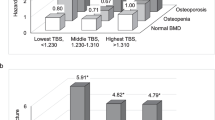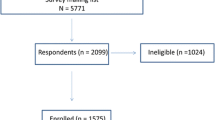Abstract
Summary
Our study found, in older adults who are residents of long-term care facilities, assessing hip microarchitecture with DXA-derived bone texture score may serve as a supplement to bone mineral density to improve fracture prediction and to facilitate decision-making for pharmacological management.
Purpose
Many patients with high fragility fracture risk do not have a sufficiently low bone mineral density (BMD) to become eligible for osteoporosis treatment. They often have deteriorated bone microarchitecture despite a normal or only mildly abnormal BMD. We sought to examine the beta version of the trabecular bone score (TBS) algorithm for the hip: TBS Hip, an indirect index of bone microarchitecture, and assess if TBS Hip brings complementary information to other bone quality indices such as BMD and bone turnover markers (BTMs) to further improve identifying individuals who are at high risk for fractures.
Methods
In this analysis, we considered baseline TBS Hip at total hip, femoral neck, and greater trochanter, TBS at lumbar spine, BMD at all of these skeletal sites, and BTMs in 132 postmenopausal women who were residents of long-term care (LTC) facilities enrolled in a randomized placebo-controlled osteoporosis clinical trial.
Results
On average, participants were 85.2 years old and had a BMI of 26.9 kg/m2. The correlation coefficient between BMD and TBS Hip at total hip, femoral neck, and greater trochanter was 0.50, 0.32, and 0.39 respectively (all p < 0.0001). The correlation coefficient between BMD and lumbar spine TBS was 0.52 (p < 0.0001). There was no statistically significant correlation between BTMs with TBS at lumbar spine or TBS Hip at total hip, femoral neck, and greater trochanter.
Conclusion
Among older women residing in LTC facilities, there was a moderate correlation between measures of BMD and TBS Hip at total hip, femoral neck, and greater trochanter, suggesting TBS Hip may provide complementary information to BMD .

Similar content being viewed by others
References
Consensus development conference (1993) diagnosis, prophylaxis, and treatment of osteoporosis. Am J Med 94(6):646–650
Johnell O, Kanis JA (2006) An estimate of the worldwide prevalence and disability associated with osteoporotic fractures. Osteoporos Int 17(12):1726–1733
Center JR, Nguyen TV, Schneider D, Sambrook PN, Eisman JA (1999) Mortality after all major types of osteoporotic fracture in men and women: an observational study. Lancet 353:878–882
Kanis JA (2002) Diagnosis of osteoporosis and assessment of fracture risk. Lancet 359(9321):1929–1936
Schuit SC, van der Klift M, Weel AE et al (2004) Fracture incidence and association with bone mineral density in elderly men and women: the Rotterdam Study. Bone 34(1):195–202
Wainwright SA, Marshall LM, Ensrud KE et al (2005) Hip fracture in women without osteoporosis. J Clin Endocrinol Metab 90(5):2787–2793
Wainwright SA, Marshall LM, Ensrud KE, Cauley JA, Black DM, Hillier TA, Hochberg MC, Vogt MT, Orwoll ES, Study of Osteoporotic Fractures Research Group (2005) Hip fracture in women without osteoporosis. J Clin Endocrinol Metab. 90(5):2787–93 https://doi.org/10.1210/jc.2004-1568
Samelson EJ, Broe KE, Xu H, Yang L, Boyd S, Biver E, Szulc P, Adachi J, Amin S, Atkinson E, Berger C, Burt L, Chapurlat R, Chevalley T, Ferrari S, Goltzman D, Hanley DA, Hannan MT, Khosla S, Liu CT, Lorentzon M, Mellstrom D, Merle B, Nethander M, Rizzoli R, Sornay-Rendu E, Van Rietbergen B, Sundh D, Wong AKO, Ohlsson C, Demissie S, Kiel DP, Bouxsein ML (2019) Cortical and trabecular bone microarchitecture as an independent predictor of incident fracture risk in older women and men in the Bone Microarchitecture International Consortium (BoMIC): a prospective study. Lancet Diabetes Endocrinol 7(1):34–43. https://doi.org/10.1016/S2213-8587(18)30308-5
Kleerekoper M (2006) Osteoporosis prevention and therapy: preserving and building strength through bone quality. Osteoporos Int 17(12):1707–1715
Chang G, Boone S, Martel D et al (2017) MRI assessment of bone structure and microarchitecture. J Magn Reson Imaging 46(2):323–337. https://doi.org/10.1002/jmri.25647
Cheung AM, Adachi JD, Hanley DA et al (2013) High-resolution peripheral quantitative computed tomography for the assessment of bone strength and structure: a review by the Canadian Bone Strength Working Group. Curr Osteoporos Rep 11(2):136–146. https://doi.org/10.1007/s11914-013-0140-9
Boutroy S, Hans D, Sornay-Rendu E et al (2013) Trabecular bone score improves fracture risk prediction in non-osteoporotic women: the OFELY study. Osteoporos Int 24(1):77–85
Briot K, Paternotte S, Kolta S et al (2013) Added value of trabecular bone score to bone mineral density for prediction of osteoporotic fractures in postmenopausal women: the OPUS study. Bone 57(1):232–236
Shevroja E, Lamy O, Kohlmeier L, Koromani F, Rivadeneira F, Hans D (2017) Use of trabecular bone score (TBS) as a complementary approach to dual-energy X-ray absorptiometry (DXA) for fracture risk assessment in clinical practice. J Clin Densitom 20(3):334–345
White R, Krueger D, De Guio F, Michelet F, Hans D, Anderson P, Binkley N (2021) An exploratory study of the Texture Research Investigational Platform (TRIP) to evaluate bone texture score of distal femur DXA scans—a TBS-based approach. J Clin Densitom 24(1):112–117 https://doi.org/10.1016/j.jocd.2019.06.004
Kanis JA, Johnell O, Oden A, Johansson H, McCloskey E (2008) FRAX and the assessment of fracture probability in men and women from the UK. Osteoporos Int 19(4):385–397. https://doi.org/10.1007/s00198-007-0543-5
Looker AC, Orwoll ES, Johnston Jr CC, et al. (1997) Prevalence of low femoral bone density in older U.S. adults from NHANES III. J Bone Miner Res 12(11):1761–1768
Muschitz C, Kocijan R, Haschka J, Pahr D, Kaider A, Pietschmann P, Hans D, Muschitz GK, Fahrleitner-Pammer A, Resch H (2015) TBS reflects trabecular microarchitecture in premenopausal women and men with idiopathic osteoporosis and low-traumatic fractures. Bone 79:259–266
Choksi P, Jepsen KJ, Clines GA (2018) The challenges of diagnosing osteoporosis and the limitations of currently available tools. Clin Diabetes Endocrinol 4:12
Rajaei A, Amiri A, Farsad F, Dehghan P (2019) The correlation between trabecular bone score and lumbar spine bone mineral density in patients with normal and high body mass index. Iran J Med Sci 44(5):374–381. https://doi.org/10.30476/IJMS.2019.45413
Torgutalp ŞŞ, Babayeva N, Kara ÖS, Özkan Ö, Dönmez G, Korkusuz F (2019) Trabecular bone score of postmenopausal women is positively correlated with bone mineral density and negatively correlated with age and body mass index. Menopause 26(10):1166–1170
Beck TJ, Ruff CB, Warden KE, Scott WW Jr, Rao GU (1990) Predicting femoral neck strength from bone mineral data. A structural approach. Invest Radiol 25(1):6–18
Mayhew PM, Thomas CD, Clement JG, Loveridge N, Beck TJ, Bonfield W et al (2005) Relation between age, femoral neck cortical stability, and hip fracture risk. Lancet 366:129–135
Silva BC, Walker MD, Abraham A, Boutroy S, Zhang C, McMahon DJ, Liu G, Hans D, Bilezikian JP (2013) Trabecular bone score is associated with volumetric bone density and microarchitecture as assessed by central QCT and HRpQCT in Chinese American and white women. J Clin Densitom 16(4):554–61 https://doi.org/10.1016/j.jocd.2013.07.001
Löffler MT, Jacob A, Valentinitsch A et al (2019) Improved prediction of incident vertebral fractures using opportunistic QCT compared to DXA. Eur Radiol 29(9):4980–4989. https://doi.org/10.1007/s00330-019-06018-w
Anderson DE, Demissie S, Allaire BT, Bruno AG, Kopperdahl DL, Keaveny TM, Kiel DP, Bouxsein ML (2014) The associations between QCT-based vertebral bone measurements and prevalent vertebral fractures depend on the spinal locations of both bone measurement and fracture. Osteoporos Int 25:559–566
Chang G, Honig S, Brown R, Deniz CM, Egol KA, Babb JS, Regatte RR, Rajapakse CS (2014) Finite element analysis applied to 3-T MR imaging of proximal femur microarchitecture: lower bone strength in patients with fragility fractures compared with control subjects. Radiology 272(2):464–474. https://doi.org/10.1148/radiol.14131926
Soldati E, Rossi F, Vicente J, Guenoun D, Pithioux M, Iotti S, Malucelli E, Bendahan D (2021) Survey of MRI usefulness for the clinical assessment of bone microstructure. Int J Mol Sci 22(5):2509. https://doi.org/10.3390/ijms22052509
Rajan, Remya; Cherian, Kripa E.; Kapoor, Nitin; Paul, Thomas V (2020) Trabecular bone score—an emerging tool in the management of osteoporosis. Indian J Endocrinol Metab 24(3):237–243 https://doi.org/10.4103/ijem.IJEM_147_20
Hans D, Šteňová E, Lamy O (2017) The trabecular bone score (TBS) complements DXA and the FRAX as a fracture risk assessment tool in routine clinical practice. Curr Osteoporos Rep 15(6):521–531
Pothuaud L, Barthe N, Krieg M-A, Mehsen N, Carceller P, Hans D (2009) Evaluation of the potential use of trabecular bone score to complement bone mineral density in the diagnosis of osteoporosis: a preliminary spine BMD-matched, case-control study. J Clin Densitom 12:170–176
Rabier B, Héraud A, Grand-Lenoir C, Winzenrieth R, Hans D (2010) A multicentre, retrospective case-control study assessing the role of trabecular bone score (TBS) in menopausal Caucasian women with low areal bone mineral density (BMDa): analysing the odds of vertebral fracture. Bone 46:176–81
Funding
This work was supported by the following grants: National Institutes of Health (Grant R01AG050302, Grant T32AG021885, Grant K07AG052668), and Pepper Older Americans Independence Centers (Grant P30AG024827).
Author information
Authors and Affiliations
Corresponding author
Ethics declarations
Conflicts of interest
Nami Safai Haeri, Subashan Perera, and Susan Greenspan report no conflicts of interest in the subject matter or materials discussed in this manuscript. Didier Hans is co-owner of the TBS patents and has corresponding ownership shares and position at Medimaps Group. Isabel Ferreiro is a senior clinical specialist at Med-Imaps SASU, part of the Medimaps Group.
Additional information
Publisher's note
Springer Nature remains neutral with regard to jurisdictional claims in published maps and institutional affiliations.
Rights and permissions
Springer Nature or its licensor holds exclusive rights to this article under a publishing agreement with the author(s) or other rightsholder(s); author self-archiving of the accepted manuscript version of this article is solely governed by the terms of such publishing agreement and applicable law.
About this article
Cite this article
Haeri, N.S., Perera, S., Ferreiro, I. et al. Trabecular bone score in the hip: a new method to examine hip bone microarchitecture—a feasibility study. Arch Osteoporos 17, 126 (2022). https://doi.org/10.1007/s11657-022-01168-9
Received:
Accepted:
Published:
DOI: https://doi.org/10.1007/s11657-022-01168-9




